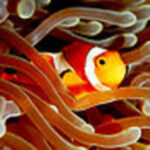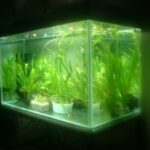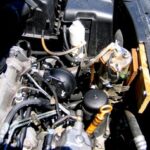Monitoring pH and alkalinity closely is a very important venue to determining the overall quality of your water. If one of these is out of wack, chances are other variables are also being affected, ultimately, leading to possible stress or worst case scenario…death to one or more of your livestock inhabitants!
PH is the measure of how large hydrogen-ion concentration is in water, or the presence of hydrogen ions(H+) versus hydroxyl ions(OH-). When the two of these ions come together, they form H2O…or water. Natural fresh water is said to have a pH of 7.0, as the amount of hydrogen and hydroxyl ions are the same or NEUTRAL. The ability of a tank system to resist upward changes in pH is said to be acidic, contrary, a resisitence to a downward change in pH is said to be alkaline.
To realize just how important pH is to the marine environment, lets take human blood which has a pH of between 7.25-7.35. This means that human blood is slightly alkaline. If we venture off too far from this level such as by increasing the amount of carbon dioxide in our blood or hyperventilated, your pH reading would go down or up resulting in stress or shock once the buffering capabilities within our blood have been exhausted. The same holds true for marine and freshwater organisms, however, marine organisms take in water more frequently and also are not able to handle as dramatic a tolerance as their freshwater counterparts. Because of this, marine organisms are affected more so with dramatic or quick shifts in pH. PH problems may not be evident initially, often requiring a day to weeks for the affects to show.
Too many times we see the wrath of pH problems when we purchase a fish and it gets placed in the plastic bag where the fish stays for sometimes an hour in the same small bag with little water. PH shock is often evident due to the lack of buffering capabilities in the small volume of water combined with oxygen depletion happening. It is adviseable to wait on purchasing a fish that you desire from your local pet shop til the fish has been out of the bag and in their tanks for atleast a week to ensure that pH problems haven’t plagued your livestock.
The pH of natural seawater in the ocean is roughly 7.8 in the deeper parts to 8.4 in the shallows. The large change is due to the fact that in shallower areas, warmer temperatures and enormous influx of algae carrying out photosynthesis tend to cause carbon dioxide to be used up affording the water to have higher levels of oxygen, thus the water is considered more basic or alkaline. As for our reef and saltwater tanks, we want to strive to keep our tanks water chemistry stable with as few peaks and valleys and fluxuations as possible for the best results. Variables such as ideal filtration, sparsely populated bioload, adequate substrate, partial water changes and avoidance of overfeeding will help to ensure that your pH is in check.
!!!NOTE OF CAUTION!!! Never attempt to alter pH changes in a short period of time rather, adjust the pH by no more than 0.2 in a 24hours timeframe is the max.
High pH readings can be reduced by adding carbon dioxide through the use of a carbon dioxide regulator or a safer and easier approach is to add acetic acid(vinegar) which breaks down into carbon dioxide in saltwater. This lowers the amount of dissolved oxygen in your tanks water therefore lowering the pH value associated with it. A low pH reading can be reversed by increasing filtration, surface aggitation through the use of powerheads and placement of powerhead at the water surface in the tank causing a more thorough air/water interface gas exchange. Dosing with Kalkwasser which has a pH value of around 12, and establishing a refugium to coexist with your main tank housing macroalgae will also help.
Alkalinity testing should also be incorporated into a stringent and beneficial water chemistry management regimine. Alkalinity is the measure of buffering capacities in water and includes bicarbonates, borates, carbonates and hydroxides. Acceptable alkalinity ranges are 2.5-3.5(7-10) dKH for reef tanks. Alkalinity, pH, magnesium and calcium levels have to be looked at together as one ultimately will affect the other. A tank that has a high alkalinity level will will maintain a high pH level however, you run the risk of calcium and magnesium becomming exhausted. A low alkalinity level is detrimental to coral in a reef tank as bleaching and decreased growth will become evident. A low calcium level will be less of a problem as long as alkalinity is balanced or elevated. Moreover, a low alkalinity level combined with a high calcium level is more detrimental to corals and Tridacna clams especially. A high calcium level of over 450mg/L can cause a loss of alkainity because the calcium carbonate can precipitate when the saturation point has been met, therefore it is best to add a two part additive to your tank consisting of calcium and an alkalinity buffering agent to eliminate the chance of calcium and alkalinity levels going in opposite directions. It is harder to maintain a fixed alkalinity level at a higher pH due to the precipitation of calcium and magnesium carbonates that occur at high pH readings.
There are a number of companies and styles of testing kits available to test pH and alkalinity and every water parameter in between. Litmus paper, dry-tablet, liquid used for colorimetric(color-measure) are cheaper and easier to use but the accuracy remains questionable. The other form called electrometric is the most reliable and is more expensive however. Electric pens, meters and gadgets give a quick and effective reading, though the instrumnet will need to be calibrated often to ensure optimal and accurate readings.
A reef, saltwater or freshwater environment can be achieved successfully long term if some guidelines are adhered to. One of the most crucial is the testing of water parameters. The testing of one parameter and reacting to that particular parameter solely will undoubtably result in disaster. Neglecting to test for the many crucial parameters will throw your tank out of wack and at the hands of your livestock so it is imperrative that you not only test for the many parameters, but do this frequently and make sure you get accurate readings, even if it means purchasing a different kit if you have any doubts or qestionable readings what so ever. When in doubt, the best line of defense is dillution…and this is done by performing a water change! A helpful hint to remember is, any time you dose with a supplement such as iodine or calcium, make sure that you are testing for the supplement to allow you to visualize if you are dosing correctly as an overdose, especially by iodine, can be lethal.






